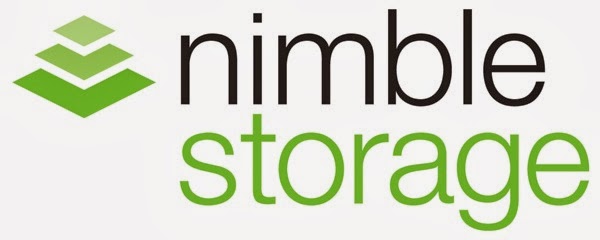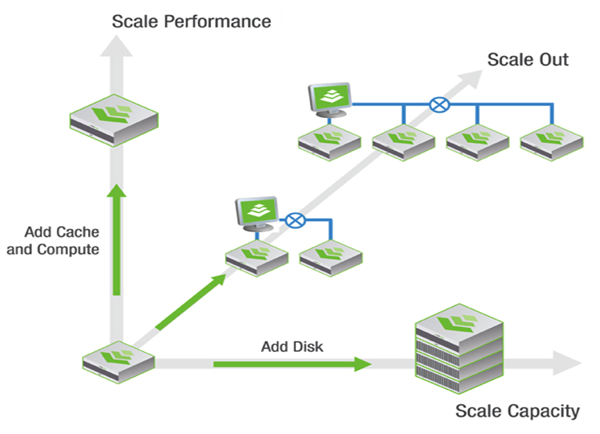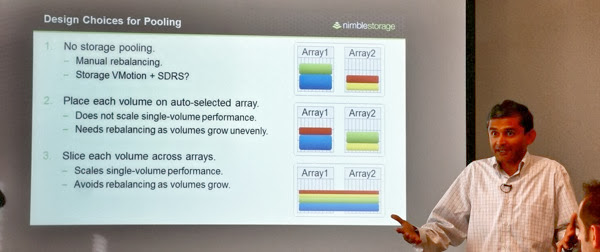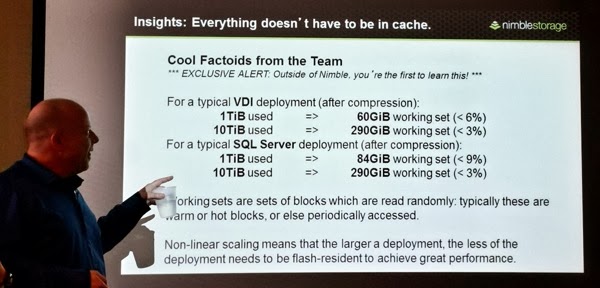This post is part of a series of 10 vendors that have presented their technology to the TechFieldDay attendees, gathered for this edition of Storage Field Day 4. You can find all background about the project here: http://techfieldday.com/event/sfd4/ – This series of blogposts were live notes, published at the end of the presentation but reviewed afterwards. Disclaimer: the attendees are not personally compensated other than our transport and lodging, nor are we obliged to write anything at all.

Company
- Founded: 2008
- Founders: Varun Mehta (VP Engineering), Umesh Maheshwari (CTO)
- Financial Status: C-round (IPO planned for 2014)
- CEO: Suresh Vasudevan
Technology
The scaling scenario at Nimble is Scale-Up first, Scale-Out later. You can replace controllers by higher end node controllers for example. Today Nimble presented their scaling OUT strategy. A Scale Out Nimble group can contain multiple pools and a pool can contain multiple arrays. A volume is assigned to a pool. Today the pools today scale to 4 dual controller arrays. And there can also only be 4 arrays on a group. So you could have 2 pools with each 2 arrays or 4 pools with 1 array, … Behind the scenes two 15TB arrays would then become a single 30TB device with double the amount of connections.

Now comes the exiting part: this could be two existing arrays with existing data. The arrays will distribute the existing data over the total pool of data. The granularity of slices is a few MBs. For placing the slices Nimble uses “consistent hashing”. For access to the correct array the Nimble has it’s own MPIO that knows what slice should go to what array instead of having to talk to a ‘LUN-owner’ like other vendors do. The MPIO drivers exist for both Microsoft and vSphere hosts. The slices are balanced over the nodes only on capacity/volume, not on performance. So you’ll have to chose the same capacity/performance ratio models in a pool! A good sidenote is that volumes residing in different pools can reside in a consistency group for snapshotting for example.

InfoSight is the second part of the presentation. In short NimbleStorage logs everything that happens from a telemetry angle on all arrays out there (over 4000 today) and then do some analysis on top of that in the InfoSight Engine. One of the results you can have with this is if you see an issue starting at one customer, you would know exactly what other customers that will/are going to benefit from the firmware updates. A good example here is that Nimble knows from real environments how to size caching for different type of workloads. Sidenote here: the big data engine NimbleStorage is using is HP Vertica.

My take
This is a presentation a lot of us have been waiting for. Nimble launched at TechFieldDay, just 3 years ago and today has more than 1000 customers with more than 4000 appliances installed. Needless to say that they are successful. Scaling beyond one system has been a question for a while. I honestly think Nimble did very well here. There are still few thing that I would like to see differently though. I would really love to see them balancing and rebalancing volumes according to performance useage (hot-cold blocks). If they don’t do that, you get the risk of having all the hot blocks from 4 arrays together on one node and I guess that’s not what we were expecting from scale-out, no? A second benefit could be that you can interchange performance and capacity models (like EqualLogic).
I do want to give Nimble a challenge for the future: NetApp has <milked the cow> of their one-size-fits -all until the market really got fed up with it and in the end they lost the battle because you simply cannot keep beating a dead horse. For Nimble that dead horse in the long run could be iSCSI. iSCSI simply doesn’t scale to dozens like Nimble is doing it today. They will either have to chose not to distribute their volumes over ALL nodes or they will have to step away from iSCSI as such. But that’s not for today! For today this solution with up to 4 dual controller NimbleStorage boxes fits PERFECt for their target audience.
Links
- website – http://www.nimblestorage.com/
- twitter – @NimbleStorage
Video
The 4 parts of the Store Field Day 4 were: Introduction / Demonstration / Deep Data Analytics / InfoSight behind the scenes